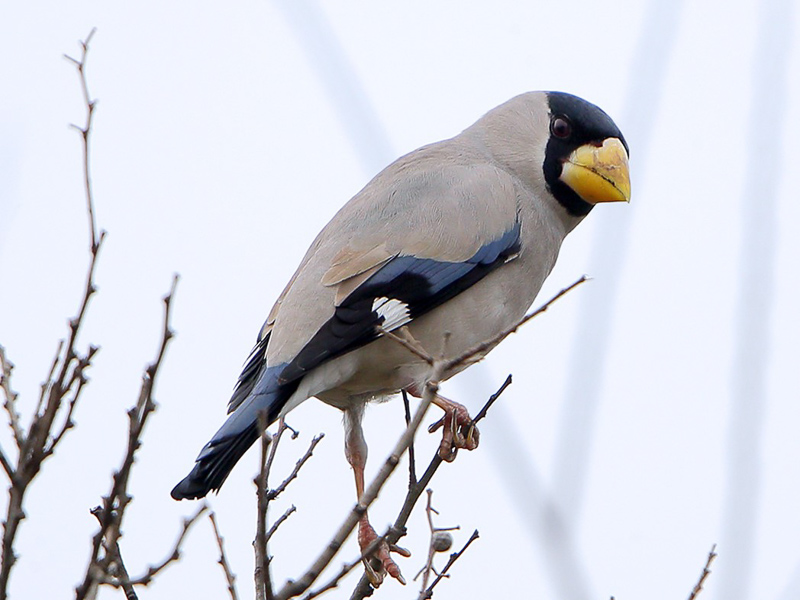Japanese Grosbeak Eophona personata 黑頭蠟嘴雀
Category I. Rare winter visitor and passage migrant to lightly-wooded areas mainly in the New Territories.
IDENTIFICATION

Jan. 2015, Michelle and Peter Wong.
18-23 cm. Both males and females have black on the head. The pattern differs from Chinese Grosbeak in that the black extends only narrowly below and behind bill, reaches only the rear of the eye and does not extend as far back on the crown. In addition, it lacks white tips to primaries, and the underparts and upperparts are uniform greyish (slightly buff on scapulars and paler on rear of underparts) while the bill is more massive and often has some greyish on the upper mandible but no black tip. Female has duller wings.
VOCALISATIONS
The call, uttered either in flight or when perched, is a moderately high-pitched single or double-note ‘chek’ or ‘chup’. This differs from Chinese Grosbeak in being slightly fuller and lower in pitch.
The song is a pleasant modulated and fairly rich whistled refrain, similar to that of Chinese Grosbeak. However, each strophe is generally shorter, while the constituent elements are purer and shriller.
Due to the popularity of this species in the bird trade, links to vocalisations are not provided by Xeno-canto.
DISTRIBUTION & HABITAT PREFERENCE
Occurs in open-country areas with scattered trees or park-like habitats, with Lam Tsuen the site at which it is most often recorded. Has also occurred at sites such as Shek Kong Airfield Road, Fanling Golf Course and Kowloon and Yuen Long Parks.
OCCURRENCE
First recorded in 1985 (Chalmers 1987), Japanese Grosbeak is a less than annual and somewhat erratic winter visitor and passage migrant of which records may not occur for several winter periods consecutively. Extreme dates are 8 November and 28 April, though most records have occurred in the period from December to mid-April (Figure 1). The peak in April is due to the occurrence of migrant flocks, the highest of which is an exceptional nine at Lam Tsuen on 11 April 1997; the next highest is five at the same site on 5 April 1995 and three at Fanling Golf Course on 1 April 2020. In contrast, the highest midwinter count is two.
BEHAVIOUR, FORAGING & DIET
Feeds on seeds and fruit, but no details. Apparently similar foraging behaviour to Chinese Grosbeak with which it associates, and thus can be seen on both ground and in trees, where it can be rather difficult to see despite its size. May perch prominently at the top of bare branches.
RANGE & SYSTEMATICS
Breeds in southeast Siberia, Sakhalin, the northern half of Japan, winters in southern Japan and south and southwest China. In China summer visitor to northeast and winter visitor to southern coastal areas including Taiwan (Liu and Chen 2020).
Two subspecies are recognised, with the nominate confined to Japan and magnirostris breeding in southeast Siberia and northeast China and wintering in south China, including HK. The latter taxon is larger in bill and body, paler and has a smaller primary patch.
CONSERVATION STATUS
IUCN: Least Concern. Population trend stable.
Figure 1
Figure 1.

Clement, P. (2020). Japanese Grosbeak (Eophona personata), version 1.0. In Birds of the World (J. del Hoyo, A. Elliott, J. Sargatal, D. A. Christie, and E. de Juana, Editors). Cornell Lab of Ornithology, Ithaca, NY, USA. https://doi.org/10.2173/bow.japgro1.01
Chalmers, M. L. (1987). Records Committee report 1985. Hong Kong Bird Report 1984/85: 32-46.
Liu, Y. and Y. H. Chen (eds) (2020). The CNG Field Guide to the Birds of China (in Chinese). Hunan Science and Technology Publication House, Changsha.

